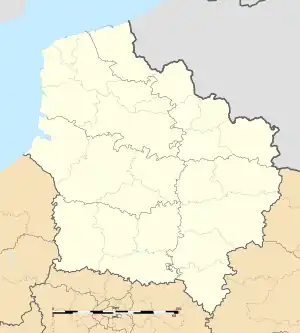Barlin | |
|---|---|
 The town hall of Barlin | |
 Coat of arms | |
Location of Barlin | |
 Barlin  Barlin | |
| Coordinates: 50°27′21″N 2°37′10″E / 50.4558°N 2.6194°E | |
| Country | France |
| Region | Hauts-de-France |
| Department | Pas-de-Calais |
| Arrondissement | Béthune |
| Canton | Nœux-les-Mines |
| Intercommunality | CA Béthune-Bruay, Artois-Lys Romane |
| Government | |
| • Mayor (2020–2026) | Julien Dagbert[1] |
| Area 1 | 6.18 km2 (2.39 sq mi) |
| Population | 7,366 |
| • Density | 1,200/km2 (3,100/sq mi) |
| Time zone | UTC+01:00 (CET) |
| • Summer (DST) | UTC+02:00 (CEST) |
| INSEE/Postal code | 62083 /62620 |
| Elevation | 51–131 m (167–430 ft) (avg. 63 m or 207 ft) |
| 1 French Land Register data, which excludes lakes, ponds, glaciers > 1 km2 (0.386 sq mi or 247 acres) and river estuaries. | |
Barlin (French pronunciation: [baʁlɛ̃]) is a commune in the Pas-de-Calais department in the Hauts-de-France region in northern France.[3]
Geography
A small ex-coal mining town, now a light engineering and farming commune, Barlin is situated 7 miles (11 km) south of Béthune and 30 miles (48 km) southwest of Lille, at the junction of the D57, D179 and the D188 roads.
History
Barlin dates to at least 1141, the year of the first mention of the parish of Barlin in a manuscript now kept in the National Archives. It was then spelt Ballin or Bellin. The name changed several times over the centuries, being recorded as Ballin in 1141, Bellin in 1438 and Barlaing in 1556; it was not until the next century that it became Barlin.
In the 12th century, the territory of Barlin was divided into several lordships that depended on Saint-Pol-sur-Ternoise, Arras or Béthune. In 1207, Thomas Hasbare was seigneur of Barlin. The Melun family succeeded him and one of their lords, nicknamed Le Brun, the king's chamberlain, saw his property confiscated by Duke John the Fearless, who had accused him of allegiance with his enemies. The Duke of Burgundy then donated the land and income of Barlin to Walleran de Juhaucourt.
In the mid-nineteenth century, coalmining began at Barlin, and the town flourished. Its mines closed in the 1960s.
Today, Barlin is a modern and dynamic place that offers its residents numerous amenities: schools, colleges, a swimming pool, a library and sports halls.
Population
| Year | Pop. | ±% p.a. |
|---|---|---|
| 1968 | 8,907 | — |
| 1975 | 8,007 | −1.51% |
| 1982 | 7,831 | −0.32% |
| 1990 | 7,948 | +0.19% |
| 1999 | 7,925 | −0.03% |
| 2007 | 7,619 | −0.49% |
| 2012 | 7,567 | −0.14% |
| 2017 | 7,661 | +0.25% |
| Source: INSEE[4] | ||
Sights
- The church of St. Pierre, dating from the eighteenth century
- The Commonwealth War Graves Commission cemetery
- The museum
See also
References
- ↑ "Répertoire national des élus: les maires" (in French). data.gouv.fr, Plateforme ouverte des données publiques françaises. 13 September 2022.
- ↑ "Populations légales 2021". The National Institute of Statistics and Economic Studies. 28 December 2023.
- ↑ INSEE commune file
- ↑ Population en historique depuis 1968, INSEE
External links
- Barlin official website (in French)
- Barlin schools' website (in French)
- The CWGC communal cemetery extension at Barlin